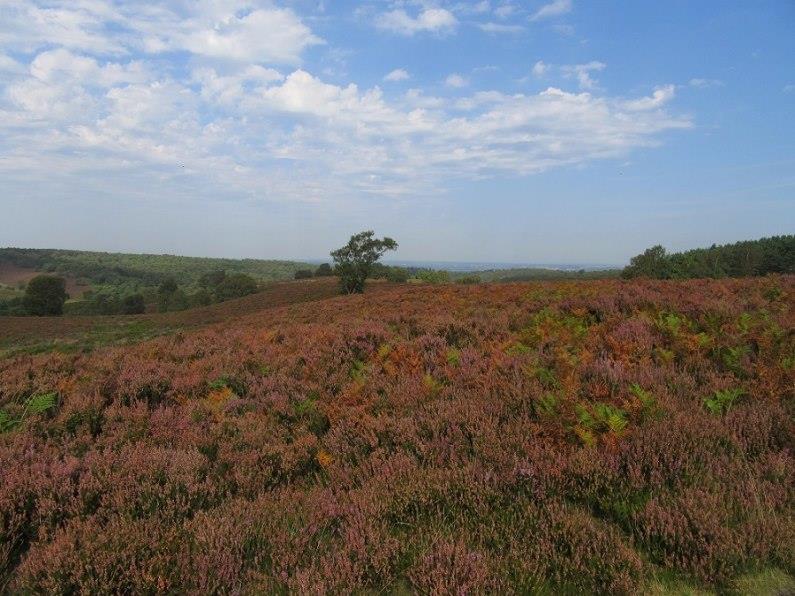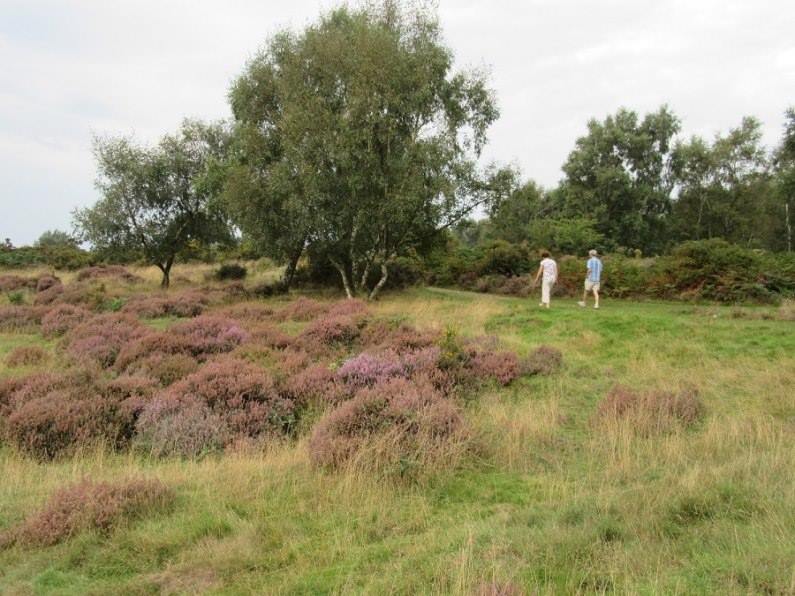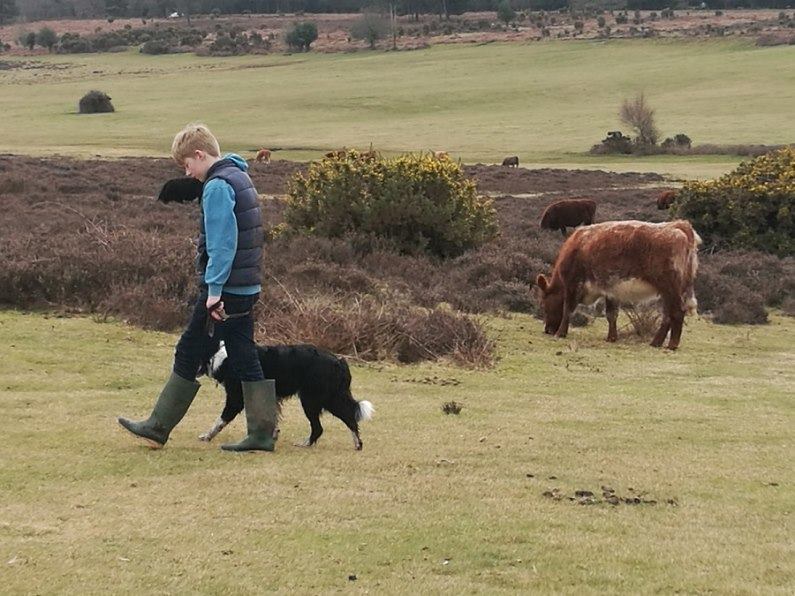Cannock Chase - Overview
We manage Cannock Chase Country Park which is a beautiful area of heathland and wood pasture in the south of the county.
Since 2016 we have been discussing and developing management proposals for the country park, discussing different options. This included types of management that have been used for many years on the Chase, such as cutting and controlled burning of heather, cutting and spot treating trees and scrub, and cutting and spraying bracken. The options also included reintroducing grazing with livestock, which was the traditional way the Chase was managed before the Great War.
The purpose of these discussions was to inform how the site should be managed under a new 10-year countryside stewardship scheme starting in 2019. The scheme must move the habitats on the Chase into 'favourable condition' for wildlife, which is a legal requirement reflecting the national and international significance of the site.
Why is grazing needed
Cannock Chase has always been known for its importance for wildlife and a significant area was officially recognised as an important place in England for wildlife when it was designated as a Site of Special Scientific interest (SSSI) in 1951. Cannock Chase consists of:
- heathland
- wetlands
- alderwood
- oakwood
- associated fauna such as wood decay beetles and sandy ground bees and wasps
All of the constituent parts that make up the Cannock Chase SSSI are protected from harm and neglect under UK law. Natural England assesses the condition of these habitats and species to make sure they are healthy and will thrive into the future.
Decades of ecological research tells us that a variety of vegetation structure across the heath, that is the presence of plants in a variety of heights and ages, makes a healthy heathland for wildlife. Therefore the condition of heathlands depends on the presence of open, warm, bare ground right up to wooded areas, as well as the presence of certain plant species such as bilberry and heathers in drier areas and bog mosses and sedges in wetter areas. This variety provides habitats for many birds, insects and reptiles as well as rare plants. The overall aim of heathland management is to create mosaics of vegetation with a varying structure that provides the warm microclimates that many heathland species rely on.

A rich tapestry of rare heathland and patches of woodland with associated wildlife make up this characteristic and internationally important area.
Low level conservation grazing is a traditional and well-used tool to manage these habitats, as part of a suite of management techniques. Indeed without grazing it is unlikely that habitats would ever reach favourable condition. Cattle can reach places that machines can’t, and their actions in creating microhabitats are almost impossible to replicate.
Natural England has put together a note about the species and habitats on Cannock Chase and the management they require. The document also outlines some of the research into the benefits of grazing open habitats.
What people said
In 2016 and 2017 we engaged with interest groups, user groups, local businesses and communities to discuss how we could bring the open habitats on Cannock Chase Country Park back into favourable condition (an optimal state for wildlife defined by Natural England). This was done through all-day workshops, drop in sessions and web-based surveys.
Key messages were:
- There was overall support / acceptance for mechanical management such as cutting heather, trees and scrub and for controlled burning
- There were concerns over the use of chemical sprays, largely in relation to impacts on pollinating insects. NB the herbicides used on the Chase are not ones associated with high pollinator impacts
- There was 58% support or acceptance for reintroducing grazing at Moors Gorse
- Views were split regarding reintroducing grazing at Brindley Heath, with around half of respondents supporting or accepting and half having concerns about the proposals
- There were strong concerns about reintroducing grazing to the main body of the country park
- Concerns about grazing related to:
- Proximity of livestock to residential areas
- Safety concerns for site users
- Welfare concerns for the animals
- Fencing off the open landscape
- Impacts for recreational use
- Specific access points, e.g. gates suitable for horses
- Impacts on watercourses and sensitive habitats and species
- Queries over costs and benefits
- There were many helpful suggestions about how these concerns could be addressed, including:
- Leaving areas near residential properties un-grazed
- Grazing in compartments so that there are always non-grazed areas people can use
- Ensuring there is an information system so that people know which areas will have livestock and can avoid them if they wish
- Phasing the scheme in / having a pilot scheme to see how it works on Cannock Chase
- Many suggestions about types of gates / access that could be used in particular locations
- Using 'invisible fencing' to minimise impacts on landscape and access
- Suggestions about types of animals that could be used
How have we used this information?
Following the public engagement, we held a workshop with the stakeholder group which included representation from different interests, including recreation, communities, environment, businesses and other site users.
At the workshop we considered all the feedback we had received through the engagement and developed ideas for how we could manage the site to get the habitats in good condition while also addressing people’s concerns. We heard from other similar sites in the country about what management they undertook and how things had worked for them.
Since the workshop, we have further developed the ideas the stakeholders generated and looked at their feasibility. We have looked further at other similar sites and learnt from their experience, and we have discussed the ideas with fencing contractors, grazing experts and potential graziers to check they are deliverable. We have also worked with our landscape and archaeology specialists to make sure we are not impacting on other special features of the site.
Current Proposal
Having looked carefully at the feedback and suggestions people made, we have amended the proposals to address the concerns that were raised while still meeting legal requirements and trying to get the best results for wildlife, heritage and for people’s enjoyment of the site.

People enjoy the mix of open heath, grassland, trees and woodlands within the Country Park.
The revised proposals include:
- In order to meet our legal requirements for the site, we propose to use all the available management methods in combination. We need all the tools in the toolbox to bring the site into favourable condition. This would include cutting heather, some controlled burning of heather, cutting and spot treating trees and scrub, and bracken spraying plus grazing with livestock.
- We propose a phased reintroduction of grazing over an extended period, starting with a small pilot scheme at Moors Gorse. Work on the pilot scheme starts in 2020/21 with around 4-6 cattle grazing the site from 2021. The pilot allows us to test invisible / virtual fencing while also enabling people to see conservation grazing in practice on a small area of the site.
- We would then develop proposals for grazing on Brindley Heath in late 2021-2022 working closely with local residents and user groups to ensure we get the best scheme possible to meet all needs; a formal consultation would be held and the decision for this scheme would be made by the Planning Inspectorate / Secretary of State. If approved, implementation would start in 2023/4. Brindley Heath (1.4 MB)
- We would then work with residents and user groups to develop detailed proposals for the body of the Chase in 2022-4; as above a formal consultation would inform the scheme which would be determined by the Planning Inspectorate / Secretary of State. If approved, implementation would start in 2025 with cattle brought onto the site in 2026. Cannock Chase grazing options (1.4 MB)
- While the detail of the scheme for the main body of the Chase would be developed over coming years, there are a number of principles we propose at this stage based on the engagement work we have undertaken so far and the suggestions people made. These include:
- An area at the northern end of the site would be left un-grazed within the ten-year management scheme to reduce the impact on residential areas and allow a recreational area where no cattle would be encountered – a potential fence line is shown on the map: Map (1.4 MB).
- The scheme would include compartments so that large parts of the site would be un-grazed at any time so that people can avoid cattle if they wish
- There would be conventional fencing near roads and residential areas for safety reasons and to give people confidence using the un-grazed area at the top of the site
- Appropriate gates for rights of way and well used paths will be provided to ensure the site remains fully accessible
- We hope to use invisible or ‘virtual’ fencing for internal compartments where possible to reduce impacts of fencing on landscape and recreation
- There would be an information system to let people know where the cattle are at any time so that if they wish to avoid them they can.

The New Forest has successfully combined conservation grazing with high levels of recreational use for many years.
Indicative time scales for the proposals
The below information sets out indicative time scales for the proposals, taking into account the need for discussions with stakeholders and communities, formal consultation and approval processes, funding application windows and the seasonal nature of the work.
Ongoing management
- Cutting and baling heather (in appropriate season): 2019 onwards.
- Controlled burning (in appropriate season): 2019 onwards.
- Bracken spraying (in appropriate season): 2019 onwards.
- Tree and scrub management (in appropriate season): 2019 onwards.
Reintroduction of conservation grazing
Pilot scheme at Moors Gorse
- Implement pilot grazing scheme at Moors Gorse 2021 (delayed due to Pandemic)
- Evaluation of pilot: 2022 to 2023
- Continuation of grazing at Moors Gorse: 2021 onwards.
Potential grazing at Brindley Heath
- Develop grazing scheme for Brindley Heath in consultation with stakeholders: 2022 to 2023
- Formal consultation and approval process for Brindley scheme: 2023.
- Potential implementation of grazing scheme on Brindley Heath: 2024 onwards.
Potential grazing scheme for the body of the country park
- Develop grazing scheme for body of Chase in consultation with stakeholders: 2023 to 2024.
- Formal consultation and approval process for body of Chase scheme: 2024 to 2025.
- Potential implementation of grazing scheme on body of Chase: 2026 onwards.
Monitoring
Conservation grazing is carried out at very low densities, using docile native breeds. We have looked at proposed fence lines for the schemes, considering impacts on recreation, how to blend them into the landscape, how to minimise impacts on deer, and ensuring we don’t impact on archaeological features. For the main body of the Chase and Brindley Heath there will be further discussions with local residents and user groups, including looking at access points.
Update August 2021 - grazing pilot
August marks the start of the grazing pilot scheme at Moors Gorse, Cannock Chase.
The pilot has been delayed due to the pandemic, but work to make the area ready for grazing has now been completed and this small area of heathland and woodland near the Visitor Centre will be grazed by up to six Hereford traditional breed cattle until the autumn.
The area has been fenced to keep the cattle safe and a water supply and handling area installed. The fence includes special features to make it easy for deer and other wildlife to move through the area.
Cattle grazing will restore the natural management that heaths evolved with, and is more sustainable than other methods. This will help to more naturally manage the vegetation to create the best conditions to support a whole range of heathland wildlife. Find out more about Moors Gorse. The area will remain fully accessible by foot as now; this scheme does not impact on any public footpaths or bridleways.
To find out more see our frequently asked questions.